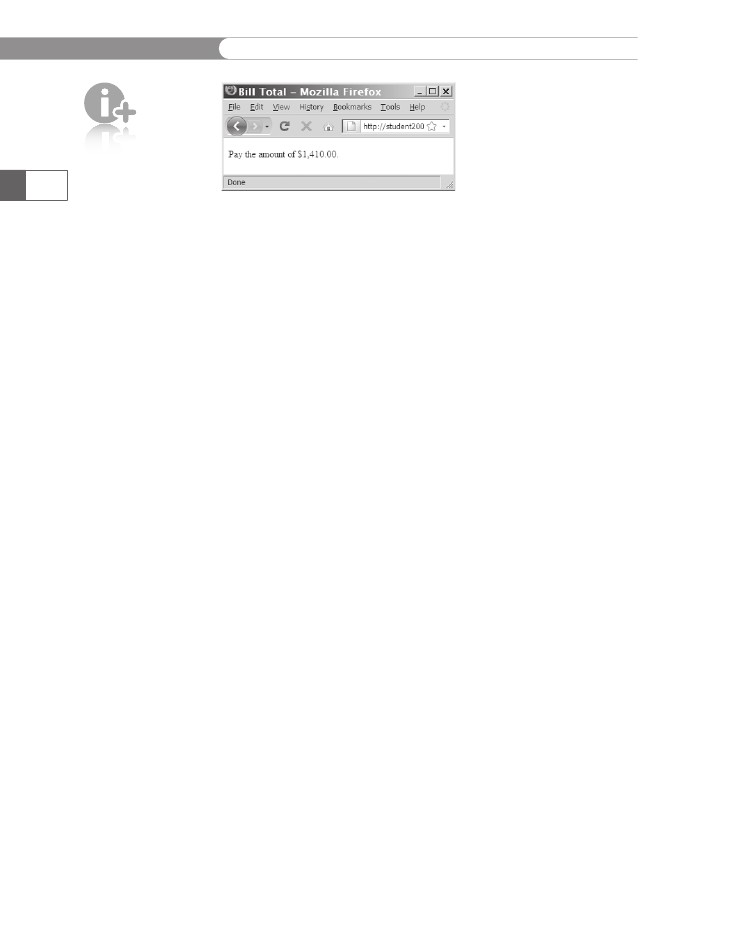
- •Initializing with Constructor Functions . . . . .
- •Into a Web page as a separate section. Although JavaScript code can
- •Is that standard php script delimiters are guaranteed to be available
- •In the block. Any text or lines between the opening /* characters and
- •2.7541 Are not integers; they are floating-point numbers. A floating-
- •Value 300
- •Is a value of 2.5, because 6 goes into 15 exactly 2.5 times. But if you
- •IsEven.Php.
- •Ing example,
- •Ing curly brace is on its own line following the function statements.
- •In php 3 and earlier, it was necessary to put a function definition
- •Is called an iteration. When the conditional expression evaluates
- •Including Files
- •13. Close your Web browser window.
- •Including Files
- •In php, you can also use two operators to combine strings. The first
- •Xhtml source code gen-
- •Input. Php provides several functions for manipulating the case of a
- •Is uppercase. If you need the reverse of ucfirst(), the lcfirst()
- •In some situations, you will need to find and extract characters and
- •Information Interchange, or ascii, which are numeric represen-
- •In comparison, the following preg_match() function returns a value
- •In the pattern is optional. The following code demonstrates how to
- •Values; any strings you validate against a regular expression must
- •Value of 1 because the top-level domain contains a valid value of .Com.
- •Is submitted using the “post” method, the form data is embedded in
- •Validating String Data
- •Xhtml tags or character entities. The message field is a text string
- •Value of the header element. For example:
- •Xhtml code within a php script section.
- •Is typically the person who created the resource. Otherwise, the net-
- •If even a single character of the Web page is sent prior to sending
- •Variables to the file_put_contents() function.
- •Xhtml hyperlink. To download a file from outside the xhtml
- •If...Else statement to display the appropriate version of the mes-
- •Iterating Through an Array
- •Iterating Through an Array
- •In Chapter 2, you learned how to use a foreach statement to iterate
- •Iterating Through an Array
- •Iterating Through an Array
- •In comparison, the following code declares and initializes
- •If ((!file_exists("MessageBoard/messages.Txt"))
- •Values from the array to create a thumbnail gallery of images in which
- •Introduction to Databases
- •Including php, allow you to create Web pages that can read and write
- •Introduction to Databases
- •Information that can be organized into ordered sets of data, and
- •Information. Each recipe in a recipe database, for instance, is a single
- •Introduction to Databases
- •Index, which identifies records in a database to make retrievals and
- •In a single table. However, you might want to break the information
- •Into multiple tables to better organize it into logical sets. Another
- •Information in one of the tables confidential and accessible only by
- •Is the employee information table from Figure 7-1. The related table
- •Is a payroll table that contains confidential salary and compensation
- •Information. Notice that each table contains an identical number of
- •Introduction to Databases
- •Introduction to Databases
- •In a junction
- •Introduction to Databases
- •In a relational format is called a relational database management
- •Is a standard data manipulation language among many dbmSs.
- •Into the query area at the top of the screen or by dragging tables and
- •It is important to understand that even though many dbmSs sup-
- •Introduction to Databases
- •If you ever
- •Is. In comparison, the bigint data type stores integer values between
- •5 Rows in set (0.00 sec)
- •Int);[enter ]
- •Important, these two tabs can cause you to lose all of the data in the
- •Internet Explorer to export the table, click the Save button in the File
- •Ifies the table being changed and the change to make.
- •It easier for you to write php code that can be used with a variety of
- •Information about queries that match one of the following formats:
- •Various types of actions, depending on the type of query.
- •Include fields for the date and time of the flight, flight number, and
- •In the ChineseZodiac folder and upload the file to the server. Open
- •Including white space,
- •Information on a Web server. When you start a new session, the
- •Introduction to Object-Oriented Programming
- •Introduction to Object-Oriented
- •Variables associated with an object are called properties or attributes.
- •In the Loan object example, a function that calculates the number of
- •Introduction to Object-Oriented Programming
- •Introduction to Object-Oriented Programming
- •Include instances of objects inherit the object’s functionality.
- •In this chapter, you will create the Web site for an online order form
- •In an online store application. The application includes information
- •Ity of building a working online store. Online store classes are very
- •Information and products. The OnlineStore class requires that store
- •Information is stored in a table containing six fields: storeId, name,
- •Information. Instead, the class simply uses session iDs to keep track
- •Variable and function as necessary, without bothering with all this
- •In a class
- •Is developed. Imagine what would happen if Microsoft distributed
- •Ing class is invalid because it does not include an access specifier:
- •If they will not be supported by future xhtml versions or are not
- •Xhtml standards. To review the guide of current w3c css specifi-
- •Information to remind yourself or others of what the code is doing. A
- •Xhtml document to the external style sheet. This link informa-
- •If you select Apache from the WampServer menu and select Service
- •Ing code uses the number_format() function to add comma separa-
- •In data that a user submits to a php script.
- •Value of “On” and the display_startup_errors directive is assigned
- •Instead. By looking at the source code, you could see that the value of
- •Ing engine can even help locate logic errors.
- •In Chapter 8, along with the equivalent mssql_* functions, where
- •Inline styles, 632
- •Xhtml, 620–635 (continued)
You can use the number_format() function to add commas that sepa-
rate thousand values and determine the number of decimal places
to display. Even if you use the printf() or sprintf() function, you
need to use the number_format() function to add commas to sepa-
rate thousands in a number. However, you should understand that the
number_format() function also converts numeric variables to strings.
For this reason, you must use the s type specifier in a conversion
specification to refer to a numeric variable that has been converted to
a string with the number_format() function. For example, the follow-
Ing code uses the number_format() function to add comma separa-
tors and two decimal places to the $Payment variable. Because the
number_format() function converts the $Payment variable to a string,
the printf() statement uses the s type specifier in the conversion
specification. Figure C-5 shows the output.
$Payment = 1410;
$Payment = number_format($Payment, 2);
printf("<p>Pay the amount of $%s.</p>\n", $Payment);

APPENDIX
C
With
UNIX/
Linux
systems,
you can
use the
money_format() func-
tion to format a number
as currency. However,
the money_format()
function is not compatible
with Windows platforms.
646
Figure C-5
Using the
printf() andnumber_format() functions together
Formatting Alignment
By default, strings are formatted with right alignment. However, if
you add a hyphen (-) immediately following the percent symbol in
a conversion specification, a string is formatted with left alignment.
For example, each of the printf() statements in the following code
contains two conversion specifications: one for the description of a
travel expense and one for the amount of a travel expense. The first
conversion specification for the travel expense descriptions contains
a hyphen (-) immediately following the percent symbol, which aligns
the descriptions to the left. However, the second conversion specifi-
cation for the amounts does not contain hyphens, so these descrip-
tions are right-aligned by default.
<p><strong>Expense Report</strong></p>
<pre>
<?php
$Travel = number_format(465.43, 2);
$Accommodations = number_format(276.2, 2);
$Meals = number_format(97.34, 2);
print("DescriptionAmount\n");
print("***********************************\n");
printf("%-15s %20s\n", "Travel", $Travel);
printf("%-15s %20s\n", "Accommodations",
$Accommodations);
printf("%-15s %20s\n", "Meals", $Meals);
?>
</pre>
In the preceding example, notice that the PHP script section is con-
tained within an XHTML <pre> element. This element is necessary
to instruct the Web browser to print the multiple spaces in the script.
APPENDIX
C
Putting
It All Together
Combining
all of the elements described in the previous sec-
tions,
the following code shows the general syntax for a conversion
specification:
%
[+][pad][-][length][.decimal]type
647
In
the preceding line of code, [+]
is
the optional plus sign. It indi-
cates
that numeric fields should always display a plus or minus sign
before
the value. Recall that the default setting is only to display the
sign
if the value is negative. This option is only used for numeric type
values.
[pad]
is
the optional pad character to insert if the length of the argu-
ment
value is less than the length specified in [length].
For zeroes or
spaces,
the character ‘0’ or ‘ ’ is sufficient. All other characters
must
be
preceded by a single quotation mark (').
If [pad]
is
omitted, the
value
is padded with spaces. This option is only used if [length]
is
specified.
[-]
is
the optional hyphen that indicates the field should be left-
aligned.
The default setting is right alignment. This option is only
used
if [length]
is
specified and the length of the string is less than
the
value of length.
[length]
is
the optional minimum number of characters to be used
when
displaying the value. If a string is shorter than the number of
characters
specified by length,
pad characters will be added until the
string
is the specified length.
Pad characters are added to the begin-
ning
of the string by default, but you can pad at the end of the string
by
specifying [-].
Strings that are longer than the length
value
will
be
displayed in full, not truncated.
[.decimal]
is
the optional number of digits to display after the deci-
mal
point for numeric values. This number is included in the num-
ber
of characters specified by [length].
You must put the decimal
point
before the decimal
value
to indicate that you are specifying the
number
of decimal places. For string values, [.decimal]
specifies
the
maximum string length. Any strings longer than decimal
will
be
truncated
to be decimal
characters
long.
type
is
the required type specifier that indicates the data type of the
data
argument. The valid type specifiers are shown in Table C-1 ear-
lier
in this appendix.
APPENDIX
Secure
Coding
with
PHP
Understanding
PHP Security Issues
Viruses,
worms, data theft by hackers, and other security threats are
facts
of life when it comes to Web-based applications. If you put an
application
into a production environment without considering secu-
rity
issues, you are asking for trouble. To combat security violations,
you
need to consider both Web server security issues and secure cod-
ing
issues. Web server security involves the use of technologies such
as
firewalls, which employ both software and hardware to prevent
access
to private networks connected to the Internet. One impor-
tant
technology is the Secure Sockets Layer (SSL) protocol, which
encrypts
data and transfers it across a secure connection. Although
Web
server security is critical, the topic is better addressed in books
on
Apache, Internet Information Services, and other types of Web
servers.
Be sure to research security issues for your Web server and
operating
system before activating a production Web site.
To
provide even stronger software security, many technology com-
panies,
including Microsoft and Oracle, require their developers and
other
technical staff to adhere to secure coding practices and princi-
ples.
Secure
coding,
or defensive
coding,
refers to writing code that
minimizes
intentional or accidental security problems. Secure coding
has
become a major goal for many information technology compa-
nies,
due to the exorbitant cost of fixing security flaws in commercial
software.
According to one study, it is 100 times more expensive to
D
APPENDIX
D
fix
security flaws in released software than to apply secure coding
techniques
during the development phase. The National Institute
of
Standards & Technology estimates that $60 billion a year is
spent
identifying
and correcting software errors. In addition, politicians
have
become interested in regulating software security. Tom Ridge,
former
Secretary of the U.S. Department of Homeland Security,
said,
“A few lines of code can wreak more havoc than a bomb.”
Government
scrutiny gives information technology companies strong
incentive
to voluntarily improve the security of software products
before
state and federal governments pass legislation that requires
such
security.
Basically,
all code is insecure unless proven otherwise. There is no
magic
formula for writing secure code, although you can use vari-
ous
techniques to minimize security threats in your programs. This
appendix
reviews some of the secure coding techniques you have
already
studied in this book.
Even
if you follow the recommendations in this appendix, your code
may
not be absolutely secure. This appendix does not list every secu-
rity
issue with PHP, databases, and Web development. As a Web
programmer,
you should continually familiarize yourself with new
threats
as they appear and modify your code to avoid the threats
whenever
possible.
For
more
information on
PHP security,
visit the PHP
Security
Consortium (PHPSC) Web
site at http://phpsec.
org/. PHPSC is an inter-
national group of PHP
experts dedicated to
promoting secure pro-
gramming practices
within the PHP
community.
649
Using Secure Programming Techniques
This section includes a number of recommendations for making your
code more secure, including tips for securing Web forms, verifying
user identities, and securing data stored in files on the Web server.
Validating Submitted Form Data
In Chapter 4, you learned how to validate data that is submitted to
your scripts. Web developers often use JavaScript with forms to vali-
date or process form data before the data is submitted to a server-side
script. For example, customers may use an online order form to order
merchandise from your Web site. After customers click the form’s
Submit button, you can use JavaScript to ensure that customers have
entered important information, such as their name, shipping address,
and so on. The problem with using JavaScript to validate form data
is that you cannot always ensure that the data was submitted to your
PHP script from the Web page containing the JavaScript validation
code. Hackers know how to bypass JavaScript validation code in an
XHTML form by appending a query string directly to the URL of
the PHP script that processes the form. Therefore, you should always
APPENDIX
D
650
include
PHP code to validate any submitted data. If your PHP script
lacks
such code, you cannot be sure that all of the necessary data was
submitted
(such as a shipping address for an online order), nor can
you
tell if a hacker is attempting to submit malicious data that might
harm
your script or your Web site. Also recall that the POST
method
sends
form data as a transmission separate from the URL specified by
the
action
attribute.
This is one reason to use POST
rather
than GET
as
the
method for submitting form data. However, you do not guarantee
the
safety of your site by having users submit form data from a Web
page
using the POST
method.
Anyone who thoroughly understands
HTTP
headers can construct a separate transmission that contains
the
form data required by your script.
To
ensure that your script receives the proper data, use the isset()
and
empty()
functions
to determine if form variables contain val-
ues.
The isset()
function
determines whether a variable has been
declared
and initialized (or “set”), whereas the empty()
function
determines
whether a variable is empty. You pass to both functions
the
name of the variable you want to check. If a submitted form value
must
be numeric data, you should use an is_numeric()
function
to
test
the variable. This ensures that hackers cannot break your code by
sending
alphabetic values to scripts that expect numeric values.
Avoiding
the $_REQUEST[] Autoglobal Array
The
$_REQUEST[]
autoglobal
array aggregates the elements of the
$_GET[],
$_POST[],
and $_COOKIE[]
autoglobal
arrays into a single
array.
Many programmers use the $_REQUEST[]
array
for the conve-
nience
of not having to determine whether a Web form was submit-
ted
using the GET
or
POST
method.
However, because the $_COOKIE[]
array
is added to the $_REQUEST[]array
last, any $_COOKIE[]
array
elements
with the same associative array key as an element in the
$_GET[]
or
$_POST[]
arrays
will be overwritten with the values from
the
$_COOKIES[]
array.
This provides hackers with a way to inject
potentially
dangerous data into your system.
Using
Sessions to Validate User Identities
Always
use sessions to validate user identities, especially at commer-
cial
sites that include shopping cart mechanisms. Because sessions
store
state information on a Web server, they are much safer to use—
provided
you properly secure your Web server. The randomly gener-
ated
alphanumeric string that composes a session ID is extremely
difficult
to guess, so hackers probably cannot use this value to imper-
sonate
a user. If a hacker does obtain another user’s session ID, he can
use
it to steal sensitive data, such as credit card information.
APPENDIX
D
Even
with sessions, however, there is a chance that a hacker can
obtain
a user’s session ID. For a detailed discussion of session secu-
rity
issues, refer to the PHP Security Consortium’s Security Guide at
http://phpsec.org/projects/guide/.
Storing
Code in External Files
Chapter
10 discusses how to store classes in external files. However,
external
files are not limited to classes; you can use them to store any
type
of code. Storing code in external files helps to secure your
scripts
by
hiding the code from hackers. This also helps to protect your code
from
other programmers who might steal your scripts and claim
them
as their own.
In
general, you should use the include()
and
include_once()
functions
for XHTML code that will not prevent a script from
running
if the external file is not available. For PHP code that is
required
for your script to execute, you should use the require()
or
require_once()
functions,
which halt the processing of the Web
page
if the external file is not available.
You
can also
use sessions
with Web
forms to
ensure that
the form data was sub-
mitted from your server
and not from a remote
site.
651
Choosing a Location for External Files
Your Web server has specific directories from which users are
allowed to retrieve files. The easiest way to ensure that a site visi-
tor cannot access a file is to store it outside those directories. As
discussed in Chapter 2, the include() family of functions can read
files stored outside of the Web structure. Files that contain secure
information or details about the underlying server should always be
stored outside the Web directory structure. This is also a good idea
for include files that do not contain sensitive information, because the
practice prevents a visitor from accessing the file directly.
For example, you could create a PHP_Includes directory at the same
level as your public_html or www directory. Within that directory,
you could include a PHP file named inc_db_info.php that assigns the
host name, user name, password, and database for a MySQL data-
base to variables named $db_host, $db_user, $db_password, and
$db_database. Then, you could add the following line of code to the
beginning of any PHP script that needs to access the database:
require_once("../PHP_Includes/inc_db_info.php"):
Because
Web site
visitors can-
not directly
access
externally placed files, it
is a good idea to store
many other types of files
outside the Web structure
as well, including log
files, data files, and
user-submitted files.
After including the inc_db_info.php file, you will need to modify your
code to use the predefined variables rather than strings. The following

APPENDIX
D
code
would be used to open a database connection using the mysql
package:
$DBConnect
= @mysql_connect($db_host,
$db_user,
$db_password);
if ($DBConnect === FALSE)
echo "<p>Connection error: "
. mysql_error() . "</p>\n";
else {
if (@mysql_select_db($db_database, $DBConnect)
=== FALSE)
echo "<p>Could not select the \"" .
$db_database . "\" database: " .
mysql_error($DBConnect) .
"</p>\n";
...
}
652
The user
account
associated
with the Web
server
needs to have read per-
missions on the include
files for the include()
family of functions to
work.
The following code would be used to open a database connection
using the mysqli package:
$DBConnect = @new mysqli($db_host,
$db_user,
$db_password,
$db_database);
Because the file that contains the database information is not acces-
sible from a Web browser, the information is more secure than if it
was stored in the public_html or www folder, or if the information
was coded directly into each script that uses the MySQL database.
Choosing an External File Extension
You can use any file extension for include files, although many pro-
grammers use an extension of .inc for XHTML files and other types
of information that do not need to be processed by the Web server.
Although you can use the .inc extension for external files containing
PHP scripts, you should avoid doing so unless your Web server is
configured to process .inc files as PHP scripts. If it isn’t, anyone can
view the contents of the file simply by entering the full URL in a Web
browser. This creates a potential security risk, especially if the exter-
nal file contains proprietary code or sensitive information such as
passwords. Because most Web servers process the contents of a PHP
script and only return XHTML to the client, your safest bet is to use
an extension of .php for external files that contain PHP code.
Accessing Databases through a Proxy User
In Chapter 7, you learned that you should create an account that
requires a password for each user who needs to access your data-
base. For most Web sites, it’s impossible to predict how many visitors

APPENDIX
D
might
need to use a Web application to access a database. Therefore,
instead
of creating a separate database account for each visitor, you
only
need to create a single account that a PHP script uses to access
the
database for a user by proxy. A proxy
performs
a request for
another
person. In general, you should create a separate account for
each
Web application that needs to access a database. You then use
PHP
code, as in the following example, to access the database for the
user
by proxy:
$DBConnect
= @new mysqli("host", "proxy_user", "password");
if
($DBConnect->connect_errno())
echo "<p>Unable to connect to the database server.</p>"
. "<p>Error code " . $DBConnect->connect_errno()
. ": " . $DBConnect->connect_error() . "</p>";
else
...
653
Changing Settings in php.ini
Configuration settings for PHP are stored in the php.ini file on the
Web server. The default settings attempt to balance security require-
ments against convenience. To secure your Web site, check the fol-
lowing settings. If you are running your own Web server, you might
be able to edit the php.ini file directly. Otherwise, you might need to
contact the system administrator for your Web server and ask to have
the settings modified.
Handling Magic Quotes
